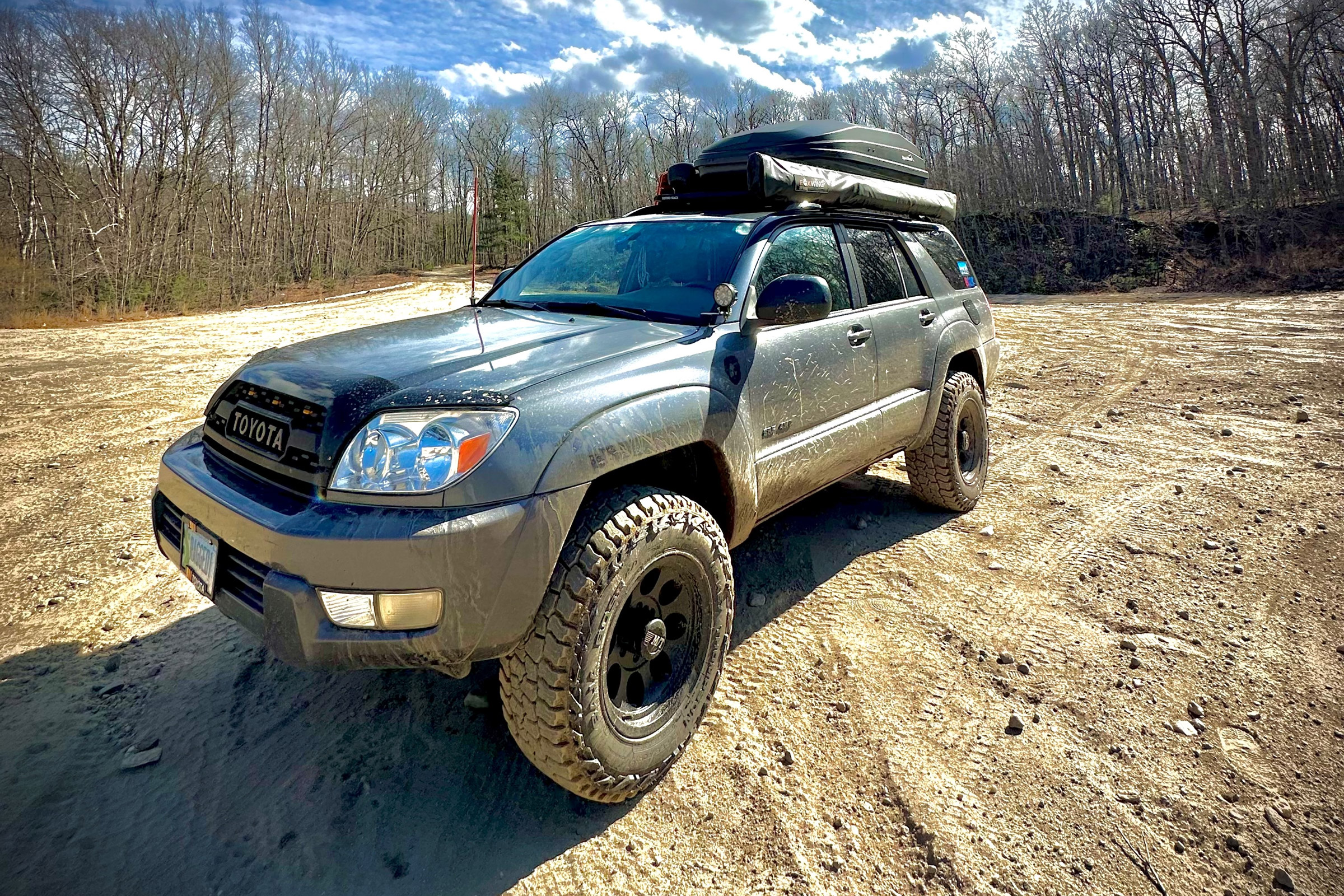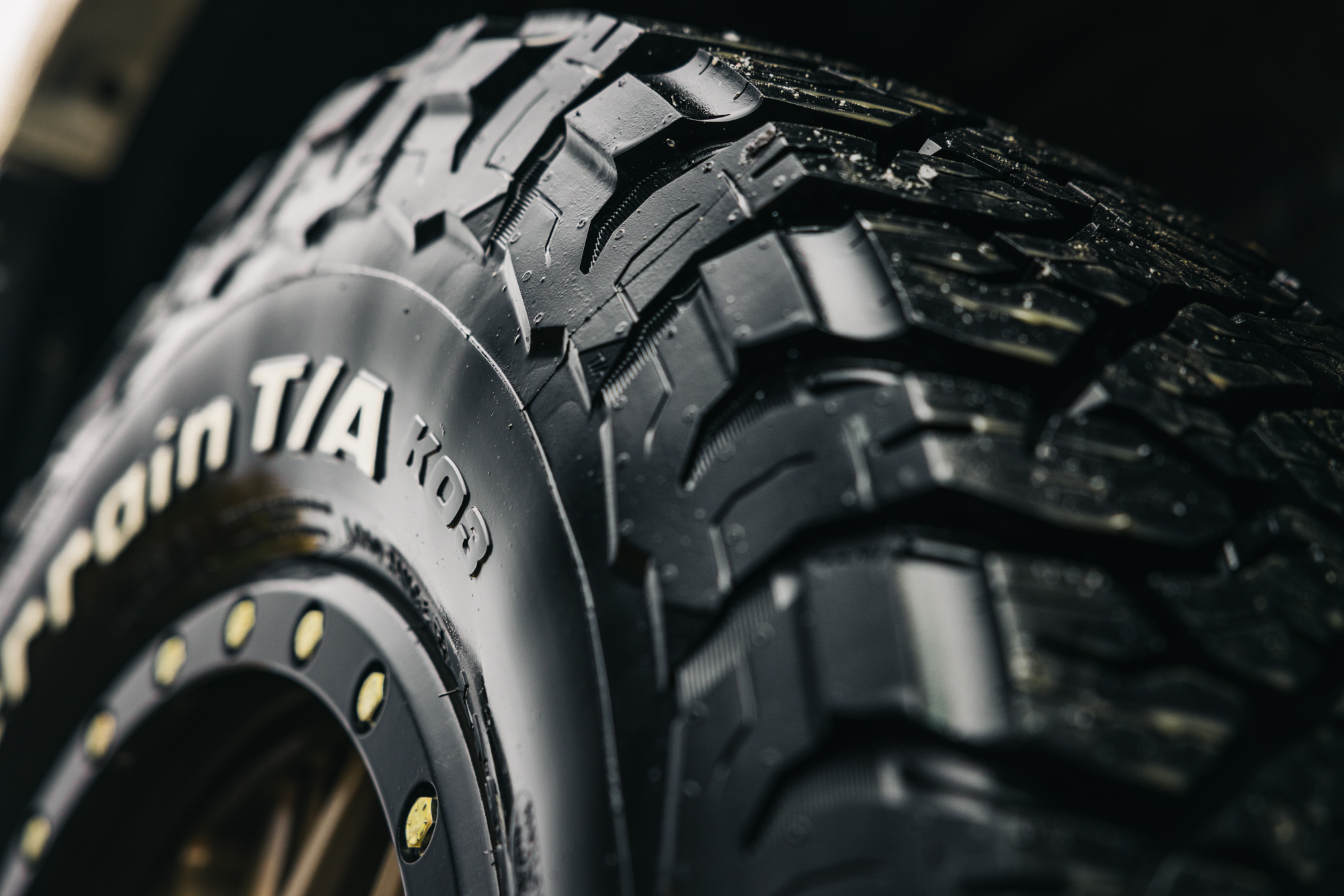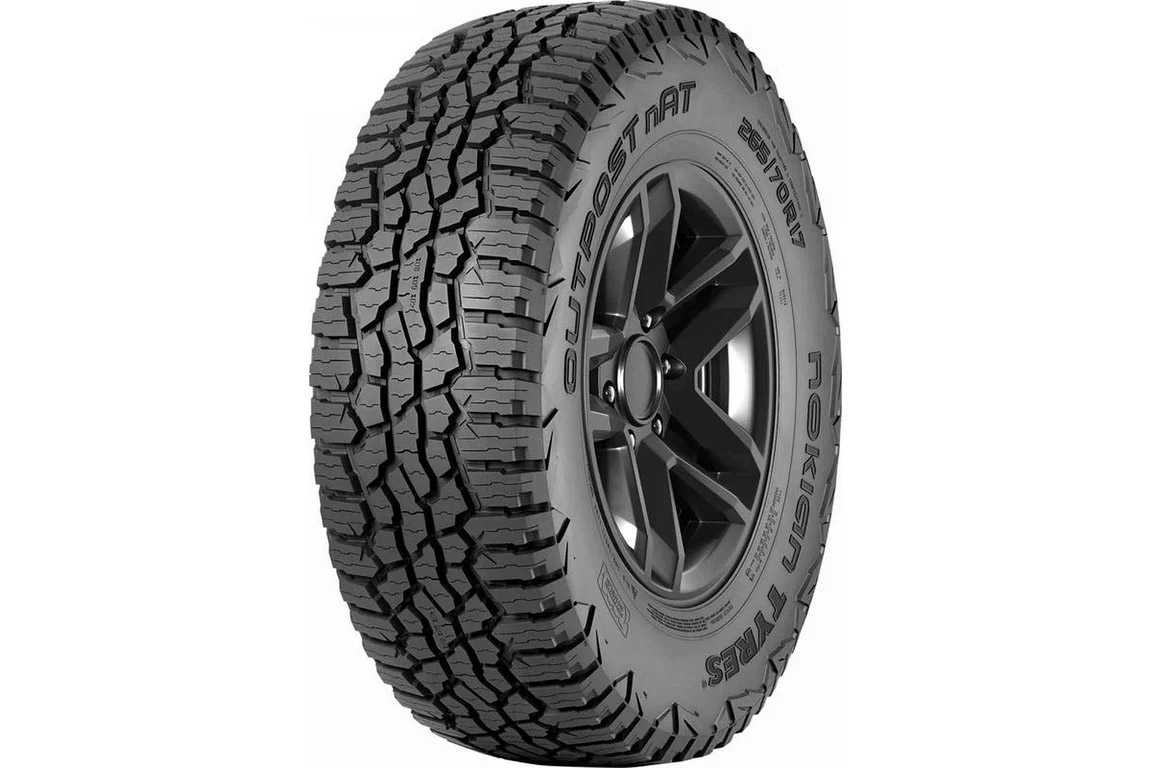Automakers don’t typically choose all-terrain tires as OEM equipment because most drivers look to all-around performance and longevity over off-roading performance. However, four-wheel drive vehicles, SUVs, and pickup trucks often need a capable tire when going off-road and are adaptable to all types of terrain. When it’s time to upgrade, deciding on the appropriate all-terrain tires comes down to weighing your needs and aligning them with your budget.
Without question, all-terrain tires offer improved traction on a variety of surfaces and make driving in difficult weather easier. Their open-tread design makes easy work in off-road driving situations, and the best ones will seamlessly transition from pavement to dirt.
If you’re a little fuzzy on the exact application, read our article that breaks down the differences between all-season, all-weather, snow, and all-terrain tires. For rigs sure to go off-road, a quick read of our explainer, All-Terrain vs Mud-Terrain tires, will help sort out which type of tire is best suited for your use case and vehicle.
Nonetheless, the 12 all-terrain tires listed below are a great place to start if you plan on getting adventurous or if you want an upgrade for winter weather. Skip to our Buyer’s Guide and frequently asked questions if you’re completely new to tire shopping and need a primer on what to look for.
Editor’s Note: This guide received an update on February 19, adding the BFGoodrich All-Terrain T/A KO3 to our line-up of the best all-terrain tires.
The Best All-Terrain Tires of 2024
Cooper Discoverer AT3 XLT
- Price range: $134-347
- Available rim sizes: 15-18, 20, 22
Pros
- Handles well in the snow
- Sizing to fit a wide range of vehicles
- Great value
- 3-Peak Mountain Snowflake rated and pinned for winter studs
Cons
- Wet grip has room for improvement
- Road noise not too loud but perceptible and has a distinct tone on the pavement
General Grabber A/TX
- Price Range: $144- $518
- Available Rim Sizes: 15-18, 20, 22
Pros
- Handle well in the snow
- Sizing to fit a wide range of vehicles
- Great value
- 3-Peak Mountain Snowflake rated and pinned for winter studs
Cons
- Wet grip has room for improvement
- Road noise not too loud but perceptible and has a distinct tone on the pavement
BFG HD-Terrain T/A KT
- Size: 31 available (for 16-22" wheels). Tested: LT265/75/R16
- Weight: 47.3 lbs. (as tested)
- MSRP: $419/ea. (as tested)
- Load rating: E
- Max load: 3,415 lbs. @ 80 psi (as tested)
- Tread depth: 18/32"
- Warranty: 6 yrs.
Pros
- Great traction in mud, dirt, and gravel
- Stable ride
- Heavy load rated
- Impressive chip and tear resistance
Cons
- Reduced fuel economy
- Possible tire rubbing at full steering lock
- Harsher ride when truck is unloaded
Toyo Open Country A/T III
- Rim sizes: 15-22 in.
- Price range: $115-325
Pros
- Stellar traction and performance on any terrain or surface conditions
- Steering is precise and responsive to natural effort
- Great snow grip
- Accomplished at towing and carrying large loads
- Sturdy appearance looks good, and flaunts its intentions
Cons
- Noise level is not ideal
- On-road performance isn’t the Open Country AT3’s strength
- Decreased fuel economy compared to all-season tires
- Deep mud and snow can get packed
- Price range: $210-540
- Available rim sizes: 15-18, 20, 22
Pros
- Quiet
- Good traction on wide range of surfaces
- Sizing to fit wide range of vehicles
Cons
- Picks up and flings rocks more than some models
- Only OK on mud
- Price range: $163-490
- Available rim sizes: 15-18, 20
Pros
- Great traction on wet roads and dirt
- Drive well on all terrain
- Quiet at lower speeds on highways
- 3PMSF rated
Cons
- Noisy at highway speeds
- Price range: $199-566
- Available rim sizes: 15-20
Pros
- Commendable stability on dry roads and while carrying heavy loads
- Great ride quality
- Admirable traction on hardpacked surfaces
- Outstanding durability and toughness
- Long treadwear warranty
Cons
- Noisy at highway speeds
- On-road traction is average
- Price Range: $177- $517
- Available Rim Sizes: 16-18, 20, 24
Pros
- Quiet for highway driving
- Good traction on wet roads
- Great for on and off-road use and towing
Cons
- Not great in the snow
- Price range: $200-470
- Available rim sizes: 15-18, 20
Pros
- Great crossover tire for on and off-road applications
- Deep, open shoulder lugs for shedding water
- Aggressive tread that handles muddy terrain with ease
- Impressive grip in wet situations
Cons
- Some road hum at higher speeds
- Not as "cool" looking as a true off-road tire
- Price range: $184-713
- Available rim sizes: 15-18, 20, 22, 24
Pros
- Extreme Sidebiters design is strong and will protect the sidewall
- PowerPly XD means a 50% heavier denier cord for even greater puncture resistance, quicker steering response, and greater stability
- Silica-reinforced compound resists chipping, extends treadlife, and improves wet handling and braking
- Comparatively quiet for an all-terrain tire
- Generous 50k-mile warranty
Cons
- Pricey
- Price range: $222-594
- Available rim sizes: 15-18, 20, 22
Pros
- Great on and off-road tires
- Work well in snow and rough weather
- Will fit most light trucks, crossovers, and SUVs
Cons
- Light humming noise at high speed
All-Terrain Tires Comparison Chart
| Tire | Price Range | Available Rim Sizes |
|---|---|---|
| Cooper Discoverer AT3 XLT | $134- $347 | 15-18,20,22 |
| General Grabber A/TX | $144- $518 | 15-18, 20, 22 |
| BFGoodrich All-Terrain T/A KO3 | $263-594 | 16-18, 20,22 |
| BFG HD-Terrain T/A KT | $270- $735 | 16-18, 20 |
| Toyo Open Country A/T III | $215- $435 | 15-20, 22 |
| Nokian Tyres Outpost nAT | $141- $609 | 15-18, 20, 22 |
| Falken Wildpeak A/T3W | $163- $490 | 15-18, 20 |
| Goodyear Wrangler DuraTrac | $199- $566 | 15-20 |
| Nitto Terra Grappler G2 | $177- $517 | 16-18, 20, 24 |
| Firestone Destination X/T | $200- $470 | 15-18, 20 |
| Mickey Thompson Baja Boss A/T | $184- $713 | 15-18, 20, 22, 24 |
| Yokohama GEOLANDAR X-AT | $222- $594 | 15-18, 20, 22 |
Why You Should Trust Us
This Guide is a product of GearJunkie editors Bryon Dorr, Sean McCoy, and Rachelle Schrute. Byron is the man in the driver’s seat behind all the motors and overland stories for GearJunkie, and he knows a thing or two about tires. From desert races to overland crawls, Bryon has pushed many a tire set to their limits. Bryon puts in plenty of miles each year covering auto and overland shows while staying on top of all things motors, including the latest in tires.
Sean McCoy is a lifelong hunter and fisherman, and often, his destination of choice can only be reached on bad roads or hardly-existing roads. He’s burned through his share of tires getting to hunt camp, occasionally even towing a trailer. Mud, creek crossings, and rock gardens are usually on the menu for his trusty F150, and these days, Sean swears by the Cooper Discoverer AT3 XLT.

What to Consider When Purchasing All-Terrain Tires
There is little doubt that buying all-terrain tires is a great investment for your vehicle. From driving on different terrains to dealing with tough weather, there are too many benefits to pass up on this opportunity. What are some things you should look for when deciding which tire to buy?
All-Terrain Tire Features
All-terrain tires have a few key features that contribute to their performance. First, there is the tread. The best all-terrain tires have deep and aggressive tread patterns. These tread patterns help the tire get the best grip possible on a wide variety of surfaces, especially wet, snowy, or dirty ones.
That being said, a balance between grip off-road and a pleasant ride on-road is important. All-terrain tires tend to have more road noise when driving on pavement than typical All-Season or Performance tires, but less than mud-terrains. Though many brands tout their noise-reduction technologies, some all-terrain tires will be louder than others.
Another thing to look for is the sidewall of the tire. While a lower sidewall looks cool and is functional on vehicles that stay on the pavement, it doesn’t provide the best off-road performance. For offroad driving, you want a lot of sidewall (the area between the wheel and the tread). The tall sidewall is necessary when it’s time to air down the tires and get better traction off-road without damaging the wheel.

Another benefit is that a taller sidewall provides a more comfortable ride. But, when a tire is aired down and squishy, you lose fuel efficiency and tire life. A firmer tire will perform well on asphalt but not as well on off-road terrain.
You should also pay attention to the rating of the tire when making a purchase. Tires are rated for speed, load, and conditions. If you plan on towing or hauling a lot of gear on your all-terrain tires, be sure to check the tire’s load index rating.
Frequently Asked Questions

While there are some differences between all-season and all-terrain tires, there are also many similarities. A lot of all-terrain tires also double as all-season tires. The main difference is that all-terrain tires have deeper treads for use on different terrain. But those deeper treads can also make all-weather driving easier.
Standard tires are usually designed to drive on wet or dry roads, but with all-terrain tires, you can do that and much more. So, if you plan to drive through snow or off-road conditions, all-terrain tires are your best bet.
On average, an all-terrain tire should last between 20,000 and 40,000 miles. How long they last mostly depends on how rough you are on the tires. The more wear they get from off-road driving, the more likely they will last around 20,000 miles. The weight of your vehicle, or what you are towing, will also affect the longevity of your tires.
Tires that are used more conservatively may last toward the higher end of the range. Obviously, this range is only an estimate, and there are a lot of factors that go into how long your set of all-terrain tires will last.

The purpose of all-terrain tires is to provide traction on all types of surfaces. They are designed for driving on regular roads but also on mud, dirt, and any other abnormal or unpaved terrain. They also provide more durability against road debris and naturally sharp objects, like rocks and sticks.
When towing, all-terrain tires are usually the better option over standard tires. That is because they are good for regular driving and durable enough for towing. When shopping, be sure to look at the specific tire’s weight rating to ensure it can handle the weight of whatever you plan to tow.
Though all-terrain tires won’t kill your gas mileage, they will decrease it by a few percent over more on-road focused tires. That small drop-off shouldn’t discourage you from upgrading to all-terrains, as there are a host of other benefits that make up for this decrease in fuel economy.
However, the size of your all-terrain tires can affect fuel economy greatly. If you increase your tire size when adding all-terrain tires, you can expect a significant loss of fuel efficiency. One of our editors lost close to six miles per gallon when jumping from 31-inch to 33-inch tires on his F-150! Increased rotational weight of the tire, likely a larger contact patch, and the reduced aerodynamics of the now taller vehicle are to blame.





















